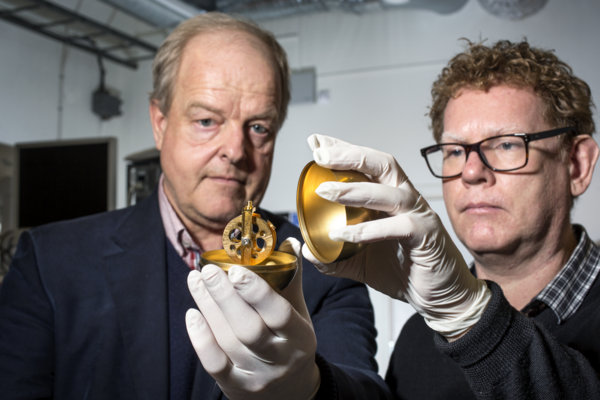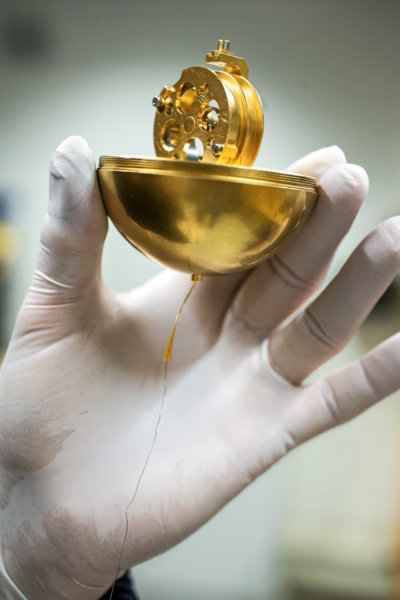NASA probe will help reveal how sun and planets interact

Space
Beginning this year, NASA will launch four satellites equipped with technology from KTH Royal Institute of Technology. The mission: to study the microphysics of magnetic reconnection, the fundamental process that happens during such solar atmosphere events as solar flares and coronal mass ejections.
Resting on a table in an office at KTH Royal Institute of Technology, lies a case containing what appears to be a gold Christmas tree ornament. Tomas Karlsson gently lifts the orb and removes its protective wrapping to offer his visitor a close-up look.
For the Professor of Plasma Physics, this baseball-sized sphere is worth more than gold. It contains electric field sensor electronics that will soon fly far above the Earth, taking measurements that will help scientists understand the interaction between the sun and its surrounding planets.
Karlsson is just one of the people at KTH working on the Magnetospheric Multiscale (MMS) project, a mission led by NASA, which will use the Earth’s magnetosphere as a laboratory to study the microphysics of magnetic reconnection – a fundamental plasma-physical process that converts magnetic energy into heat and kinetic energy of charged particles.
They have dedicated the working-hour equivalent of 10 years to constructing instruments and power supplies that will enable four satellites to take ultra-high resolution measurements of the ion and electron distributions and electric and magnetic fields within cosmic plasma flows.

Magnetic reconnection occurs universally in plasmas, the electrically conducting mixes of positive and negatively charged particles that account for an estimated 99 per cent of the observable universe. Göran Marklund, Professor in Space Plasma Physics at KTH, explains that magnetic reconnection is responsible for driving the aurora borealis and is also believed to be behind solar flares and many astrophysical phenomena.
The scientific investigation, Solving Magnetospheric Acceleration, Reconnection, and Turbulence (SMART), will also contribute to solving problems on Earth related to magnetic reconnection, Marklund says.
“In connection with solar flares and space storms, the Earth’s atmosphere is hit by intense particle flows,” he says.
The MMS project aims to understand questions such as how reconnection starts and how it ceases, as well as how it accelerates particles to high energies.
“While this is basic research, in a broader context what we are doing is mapping the space environment that is closest to Earth, which is also important for technical applications such as satellites,” Marklund says.
This not only affects the health of satellites, but also technical systems on Earth.
“These large currents flow down into the atmosphere and they can induce strong currents to power grids, burning out transformers and causing other damage,” he says. “So this kind of research is a step towards understanding these effects on the environment.”
Each of the four NASA satellites will carry four of the sensors created by KTH, which will extend from the spacecraft on 60 m long retractable wires, housed in the titanium nitride coated spherical casing, which gives them their golden hue. A prototype of the wire boom system, which resembles a fishing reel, was engineered at KTH.
Inside the ball-shaped case there is also a retractable reel, which the team has nicknamed the “yo-yo”. Around it, a short 0.24 mm wire is wound that will enable the probe to be extended even further from the end of the boom cables.
The idea is that the thinner wire helps reduce disturbance in the measurements. “There are a number of disturbances we want to avoid,” Marklund explains. “We want to be as far from the satellite body as possible because when it orbits the Earth, it leaves a wake in the plasma, just like a boat or a bus.”
In creating the instruments, the engineers also had to take into account other extreme conditions of the near-Earth space plasma environment.
Karlsson says the team had to build light mechanics and components to reduce mass as much as possible, but the gear also had to withstand harsh space radiation. “During solar storms, satellites can get killed,” he says. “We needed radiation-hardened components that can operate even in the radiation regions. In addition, these were placed in boxes with a level of thickness that protects the electronics.”
With their partners at the University of New Hampshire, the team tested the electrical and mechanical parts in simulations of the extreme heat and cold of sunlight and shadow in space.
Then there’s the problem of making sure that moving parts operate in a vacuum. “There are requirements on surface properties – lubrications that will work in a vacuum,” Karlsson says.
While the probe is designed to operate for two years, it will likely continue operating for a long time afterwards, Marklund says. The predecessor of MMS, the ESA Cluster project, probes Earth’s magnetosphere with satellites that were designed to be in service for two years, but which have actually have been in operation for 14 years. “When you build a space mission that costs USD 1 billion and it operates longer than expected, it’s unwise to turn it off,” Marklund says.
So the scientists have high hopes for a long and fruitful investigation. Their colleague, Per-Arne Lindqvist, responsible for MMS at KTH, will work with an international team of scientists who operate the instruments, collect data and analyse the results from the MMS mission.
The launch of the four satellites is scheduled for 26 November 2014.
“We will be very active in the research that follows,” Marklund says.
David Callahan